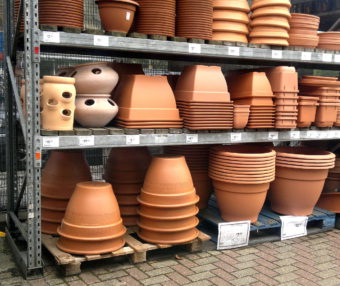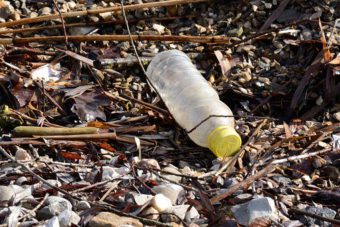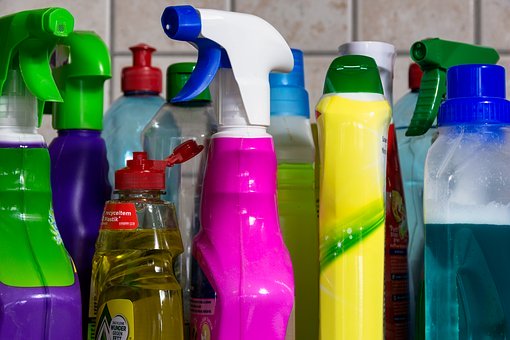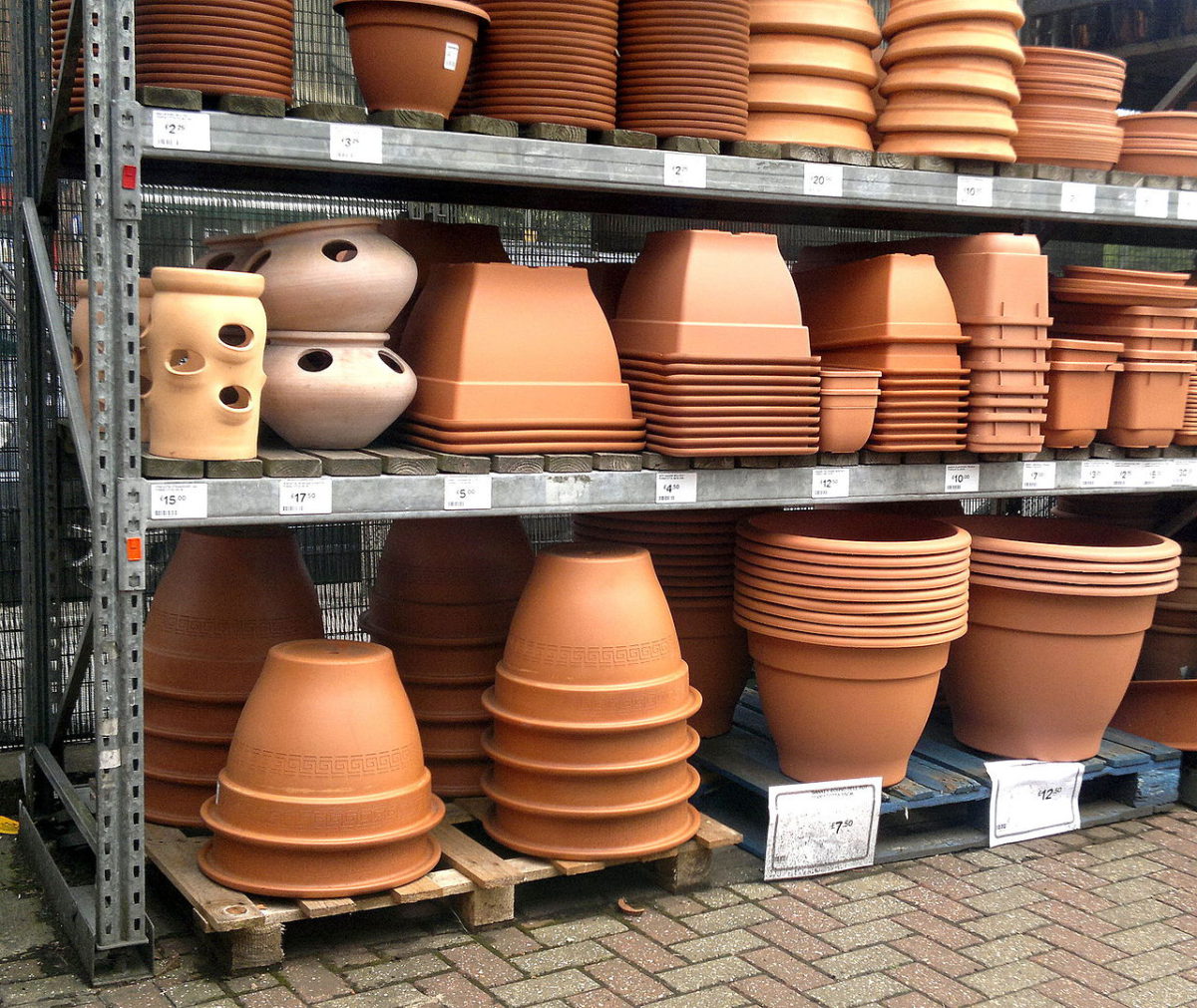In this article, we will be discussing ways of reducing your usage of plastics in the container garden. As you can imagine when you look around you can see how much the modern gardener is dependent on plastics. You find it in watering cans and hoses used to water the plants in the pots and cells we grow our seeds in, to the many containers used to house houseplants in.
The use does not stop there as it is used as a sheath on handles of pruners, spades and other tools, as well in plastic sheeting used as a weed suppressant, or used to cover polytunnels and cloches.

It is also often found in plastic wheelbarrows we used to lug our tools around and in the many electrical pieces of equipment we have in our garden; lawnmowers, shredders, hedge trimmers and other electric pieces of equipment all have plastic protection around their main body to protect the electrics and inner mechanics, and to make it lightweight.
There are plastics literally everywhere so the question arises can there be anything done to reduce the amount of waste plastics we all produced as gardeners?
We all remember watching the Blue Planet II and the effect that plastics are having on our watercourses and oceans, the effect it is having on the wildlife that lives in these water and the suffering they are enduring from consuming plastics and getting caught in plastic lying around.
Plastic use starting to become unacceptable in the garden, so we have to think about reducing it and finding suitable alternatives. Even the organic or inorganic chemicals we buy and use in the garden often come in plastic containers, which needs to be reused, recycled or disposed of.

We can put our fingers in our ears and turn a blind eye, or you can do something about it.
It may shock you but in the UK 500 million plastic pots, cell trays and seed trays are bought every year. This does not include the other plastics routinely used in the garden. The plastic trays and pots can be used multiple times but eventually, it will degrade and split and will have to be replaced and the old plastic has to be disposed of. Something has to be done.
REMEMBER THE WASTE MANAGEMENT HIERARCHY?
It helps to think about waste in general if you recall the Waste Management Hierarchy:
- First, you need to eliminate the waste your produce. You need to see if you can stop the waste being produced in the first place. The plastic you are using at the moment can it be replaced with a more long-lasting material or something which is less damaging to the environment.
- If you cannot eliminate can you reduce the amount of plastic you are using, can you make changes that will reduce your reliance on plastics?
- If you cannot eliminate or reduce the amount of plastic, can you reduce them? This includes when the plastic becomes unusable. You tend to find you cannot do much with broken pieces of plastic but you can use plastic pots and tray for a number of years if you take good care of them.
- If you cannot reuse the plastic, can it be recycled and turned back into useful products?
- If the plastic cannot be recycled then it needs to be disposed of, either by burning and recovering its energy from an energy recovery facility or disposing of in the landfill.
Obviously, we want to reduce the amount of plastic we depend on.
TYPES OF PLASTICS
You tend to find there are 7 types of plastics used in the home, all made from polymers derived from petrochemicals. The following will help you to decide if they are suitable to be reused in your garden.

TYPE 1- PET plastics that are used to make colourless drink bottles. These bottles tend to be made for single use and over time when it is exposed to UV light and/or heat it tends to break down. People tend to cut them in half and use the top half as cloches for young, tender plants. The problem is that when the bottle breaks down, they leave residues in the soil that can leach chemicals into the soil when exposed to high temperatures.
This type of plastic is easily recycled.

TYPE 2-High Density Polyethylene (HDPE) that is used for non-transparent bottles (i.e. the many of the liquid fertilisers, weed killer and solid fertilisers are made of). This is much more suitable and stable. It can take a long time to break down. It is also very recyclable, so all you need to do is wash out the finished containers and recycle them.
TYPE 3- Polyvinyl chloride (PVC) is used extensively in making water pipes, wheelbarrows, sheaths of tools and coatings from electrical machinery.

The problem is PVC comes in two forms; plasticized PVC and unplasticized PVC. The difference is that plasticized PVC contains chemicals called phthalates that make it more durable and flexible. These phthalates can leach out of these plastics and effect our natural hormones that can lead to reproduction abnormalities.
A difficult product to recycle as it needs a specialized process to do so.
TYPE 4- Low-Density Polyethylene (LDPE) is one of the most used plastic domestically, where it is used for shrink wraps, food storage and squeezable bottles. Compost bags and covering of polytunnels are made out of the same material. Generally, bottles are recyclable and bags can be recycled as long as you use a specific facility like a supermarket that will take carrier bags back for recycling.

TYPE 5-Polypropylene is used in rigid containers, such as desert pots, spread containers and many microwavable trays. It is generally durable and long-lasting. In the garden, you find polypropylene is used in flower pots, plant trays, ropes and netting, and because of its durable and long-lasting nature, it can be reused many time.
It is also recyclable but the plant pots are not due to the black colour of the material. This is because most plastics are sorted by laser light, and the machinery does not recognise it and so it passes straight through the machinery unsorted to the different types.
TYPE 6-Polystrene (PS) is used for food and take away storage containers. It is a possible known carcinogen and therefore it is not recommended to be used in the garden. Difficult to recycle, even if you use a specialized recycling process.
TYPE 7- All other plastics that do not fit into the other 6 types fall here. Many are extremely toxic and not recyclable. These are to be avoided in the garden at all costs.
IS THERE AN ALTERNATIVE?
Is there an alternative to these plastics and the simple answer is yes.
This includes Bioplastics that are made from renewable biosources, such as vegetable fats and oils, corn starch, wood waste, recycled food waste and anything else as long as it can be turned into plastic and it biodegrades.
More usage is found for them each year and within ten years it is expected that 10% of the plastic market will come from this source.
- It has many advantages:
- It lowers the carbon footprint.
- Are more energy efficient in its production.
- Does not required non-renewable fossil fuels.
- Produces less harmful waste in its production.
- No harmful additives or plasticizers are used in their production.
- They do not contaminate the food that is stored in them.
It is expected to be used increasingly in the garden. They are being increasingly used in crockery, cutlery, in bowls and straws. It is good news but more research will be needed before it can be used to replace all plastics made from petrochemical.
WE ALL NEED TO MAKE CHANGES
As said early in this article 500 million plant pots and trays are brought every year in the UK, where nearly all of it going to landfill where it remains in the ground for the next 500 years.
We need to all start to reduce the single-use plastic in our garden, in our garden centres, in our nurseries and from the manufacturers. We also need as consumers to put pressure on those the make or use or sell pots to reduce, reuse and recycle the plastic in their processes and to help us, gardeners, to do so.
It has to be a mutual relationship that helps all from top to bottom.
HOW TO REDUCE PLASTICS
The best thing you can do is simply not buy them. I know it cannot be simple for some things like electrical machinery which needs plastic coatings to protect the inner machinery and to make it lightweight. But for others, it is simply finding wooden handles for tools, or using non-plastic pots and trays, or going for a glass greenhouse instead of a polytunnel.
Instead of using that plastic weed suppressant membrane, you could use thick cardboard laid down on paths and on top of that gravel is added that makes it more long-lasting.
Small biodegradable pots can be made out of coir, woodchips, rice husks, miscanthus or even seaweed. In fact, there are two types of biodegradable pots that can be used.
TYPE 1 is made from fibre that is great for growing seeds in it for transplanting your seedling into. They tend to last a growing season, where the roots poke through the pot. The advantage is that the pot can be directly planted into the ground or in a container.
In my experience, it is best to break the pot down by gently ripping it at the sides before planting them. They seem to do better this way, as the roots can grow into the soil that surrounds the fibre pot. One other thing that you have to make sure that the fibre pot I soaking wet before planting as this will help the plant to establish much quicker.
TYPE 2 is made out of bamboo, rice husks and latex. They can last a few years and therefore can be reused before finally composting the broken and degraded pots. Much more environmentally friendly and you get more value for your money.
YOU NEED TO MAKE LITTLE CHANGES
You can also buy bamboo seed trays that should give a number of years’ service and you can also buy wooden seed labels. In my experience, do not use permanent markers with wooden seed labels, as over time the writing fades and you have forgotten what you have planted. Pencil, on the other hand, is much easier to read and does not fade over time.
You can make sure that your watering can is made out of galvanised metal and that your compost bin is made of wooden slats. Easy to construct and better to recycle once its use is over.

In fact, it is good to replace as much plastic in the garden with as many wooden products, as they are compostable and easy to replace.
Try to go for totally metal wheelbarrows or if you cannot find one that has the least amount of plastic associated with it.
You need also need to be proactive to get your local garden centre, nurseries and plant suppliers to use biodegradable pots. If you do not buy them, then guess what they will not supply them.
You can also have to see if your local garden centre will take old pots back, so they can reuse them or recycle them. Put pressure on them.
MAKE YOUR OWN POTS
One of the easiest methods is to make your own seed pots using old newspaper and a paper pot maker. Normally the pot maker comes in two sizes to either make a short, larger diameter one or a tall, skinny one, depending on if the plant is deep-rooted or not.
The problem with these paper pots makers is that they tend to produce pots that fall apart with excessive watering, especially if the paper is wet. You will need something to hold the pots in or believe me they will start to bow down to the ground.
I would use something like a cardboard egg box or you have to make a rack for them. A trick I use is to place them in a gravel tray then prop them up using kitchen paper in between the gaps. After use, the kitchen towel can be composted. They also do have a tendency to dry easily, so you will need to keep up the watering.
Finally, you can save your toilet rolls and kitchen roll centre tube, and you can use them to grow runner beans, sweet peas and any other long-rooted plants.
GO FOR ALTERNATIVES IN THE CONTAINER GARDEN
In container gardening, we tend to use large containers everywhere from 7cm up to 1m or more. I know it is easier to use plastics, as it is easier to make the drainage holes and they are lightweight, making transport easier.
These plastic containers can last a while but eventually, they will either degrade over time or be accidentally broken (do not blame the cat). You can use alternatives, be it terracotta pots (you can even buy terracotta seed pot) or ceramic pots (glazed or unglazed), stone pots, or you can buy metal containers (either galvanized, stainless steel or stressed rust kind of look).
One not so obvious way to make it easier to recycle is to avoid using black plastic as they are difficult to recycle. As black is not the only colour you can buy, instead buy pots made of any other colour. If they are made out of polypropylene and it is not black they could be recycled, but this is so dependent on your local authority. I know the variation is wide throughout the country in what plastics are accepted and what is not. You will have to check with your local council to find out.
IF YOU HAVE PLASTICS, WHAT CAN YOU DO?
First, you need to take care of your existing plastic items to make sure they last as long as possible. I know plastics quickly deteriorate over time, and trays and pots will eventually need to be replaced. This is when you can buy the non-plastic alternatives. Use the pots and trays, again and again, is best, but if you have too many, much more than you need or can handle give some to your friends, family, neighbours, gardening charities, allotments or even schools, anything free is often gobbled up quickly.
It is amazing how quickly you can accumulate so many pots.
All gardeners are guilty of this but you will have to try to curb your plant buying capabilities.
REPAIR AS MUCH AS POSSIBLE
Propagation lids and thick plastic pots that go holey or develop a tear can be repaired, so you do not need to throw them away. Propagation lids can be fixed with clear tape, whilst black pots can be fixed with black duct tape. Do not be too keen to throw things away.
In order to stop metals tools with plastic handle rusting over time, where it will need to be replaced, you can oil and clean them regularly. If it ain’t broke, do not throw them away.
Old compost bags can be used to grow potatoes in or to put your garden waste in, where you can use them to predispose your garden waste in the Household Waste Recycling Centres.
One of the most important ways to encourage recycling is to buy products that are made out of recycled products. If you buy any garden products make sure that are made out of recycled material, then suppliers and manufacturers will get the message.
As they say that it is up to you.
CONCLUSIONS
In this article reducing plastic waste in the container garden has been discussed. As you can see there is a number of methods that can be used in the garden to break the plastic habit. You can start using biodegradable pots, bamboo seed trays and start using tools that have only wooden handles rather than plastic.
Go for terracotta, ceramic, stone, or metal container and buy metal watering cans, wheelbarrows and so on. If you are conscientious, you can easily reduce your plastic usage,
If you cannot reduce your plastic usage, you have to make sure that you do everything possible to make them last longer, even if it needs a quick repair. Clear tape is good for clear plastics and black duct tape is good for black pots and trays.
It is not only for you to change your ways, but for you to change your thinking.
You need to put pressure in your garden centres, nurseries, online shops, manufacturers and even your local councils to change their ways.
If we all change our ways and buy more recycled products then they will make more.
It is not only about change but how we garden as well. From one small acorn, a mighty oak tree grows.
If you have any questions or comments, please do so in the comment box below,
Go green, avoid black.






I totally agree with you. We need to reduce the amount of plastic we use for our yards and flowers. From your post, I learned a lot about the types of plastic and how dangerous it is to our environment. I’m really going to try to replace all my plastic pots with eco-friendly pots, such as bamboo ones.
Hi Bluemoon
I do hope you do start to reduce the amount of plastics that you use in the home and in the garden. We all need to become more environmentally friendly. If we do not then we can end up in a much worse situation. Anything you can do to minimize plastics is most welcome.
Thanks
Antonio
Wow! I had never really given too much thought to this that the dependency rate on plastic is way too much and there needs to be a reduction in need and this is really a great wake up call. To say I value what I read here would be an understatement. Thank you for sharing here. I surely would put this into consideration on my container gardening. Thanks
Hi Rodarrick
Thank you once again for stopping by and giving such an insightful comment. We all rely on plastics too much and we have all become complacent. We need to put the needs of the planet before our own, otherwise we will be putting future generations with a lot of trouble.
Thanks
Antonio
the fact that the decomposition rate of plastics is very slow makes it not conducive for farm use. i knew little about the bio plastics but i have been able to understand some examples and the reason why it stands as alternatives. thank you very much for this post. it is really helpful
Hi Benny
Thank you for stopping by and commenting. I do think that bioplastics are the way forward and we needs to adopt new practices in the way to garden so we do not use single use plastics and look to alternatives.
Kind regards
Antonio
You have made some excellent points in this article, and some that I haven’t thought of before. I never really thought about how much plastic we actually use in the garden. Hopefully, now this will make me much more aware.
I think I am going to change the plastic for terracotta posts, as these are not only attractive but stronger and better for the environment as well.
Hi Michel
Thank you for commenting. I really commend you on changing to terracotta as this will be very much less damaging to the environment. We all need to make sacrifice if we want to live in this world.
Kind regards
Antonio
Hi Antonio,
I loved your article.
I couldn’t agree more about the usage of plastic on not only our gardens but our kitchenware, tools and so much more and having alternatives to combat plastic usages is crucial to saving our earth from contamination.
And steel and other alternatives are great options.
Thank so much for the information.
Hi Michael
Thank you for those kind words and I could not agree with you much more. We need to take a serious look at ourselves to find ways we can make changes and to improve our lives and the lives of others. From small changes big things can happen.
Kind regards
Antonio
It makes such a refreshing change to read an article that actually provides solutions to the problems that are being discussed. Plastic waste is the ‘hot potato’ at the moment and rightly so. The images of the huge floating islands of plastics in our oceans is nothing short of heart-braking. Apart from the environmental problems is causes, there’s the damage to those species that live amongst it.
The figure you quoted, of 500 million plant pots being sold each year, is quite staggering. We can and should try and do better than we are. Within your article you have provided solutions that are extremely workable. Being more careful with our handling of plastic materials, so as to increase longevity, is something we can do straightaway.
I didn’t realise that certain plastics actually ‘leach’ chemicals into the soil. Alternatives should be sort, sooner rather than later. Bioplastics should be something that all of us are looking to use, from this day forward. Work to be done.
Hi Twack
Thank you very much for your continuing support and for raising this comment. You are right in so many levels and we can all look at ways in our lives to reduce our dependency on plastic. We can all make repairs to the plastics we use, we can use alternatives and we can use plastics that have much more longevity. It is shocking about how much plastics gardeners produced and it is time we all take responsibility.
Bioplastics are the way forward and we need more research before they can be safely used in the garden.
Kind regards
Antonio
I absolutely love this awesome post on reducing plastic dependence in the garden.
To be honest, it would do individuals and the world a lot of good if plastic production is reduced not just in the garden, but in every other part of the home.
Your specific explanation of the LDPE was what I liked most, as plastic bags are now unfortunately becoming a part of our nature. I visited a community one time where plastic production was in vogue and I found out that it really was affecting the general wellbeing of the entire environment.
I think people need to learn that using more of plastic can never be beneficial to their wellbeing. Recycling and reusing them are definitely great ways to tackle the issue. But reducing our reliance on them is best way.
Thanks for this article. I’m sharing this right away.
Hi John
I could not agree with you more, as we need to seriously look at our lives and think about ways we can replace plastic as a main product in our garden. We need to look at alternatives from the tools we use to the containers we have our plants in. We need to make as many changes as possible so that we do not contribute to the problem for future generations to deal with. I have come up with suggestions and I hope you implement them
Thanks
Antonio
Hey, I enjoy a lot while reading your guide on reducing our dependency on plastic in our garden. Your step by step methods are very useful for everyone to reduce the dependency of plastic in a garden. Bioplastics that are made from renewable biosources, such as vegetable fats and oils, corn starch, wood waste, recycled food waste and anything else as long as it can be turned into plastic and it biodegrades. Thanks for upgrading our knowledge.
Hi Parveen
Thank you once again for stopping by and commenting. We all need to make changes in our person habits being it in our homes or in our gardens. We all need to look at alternatives.
Kind regards
Antonio